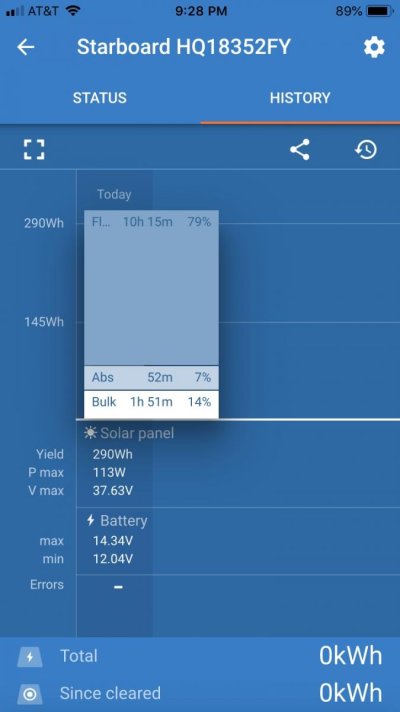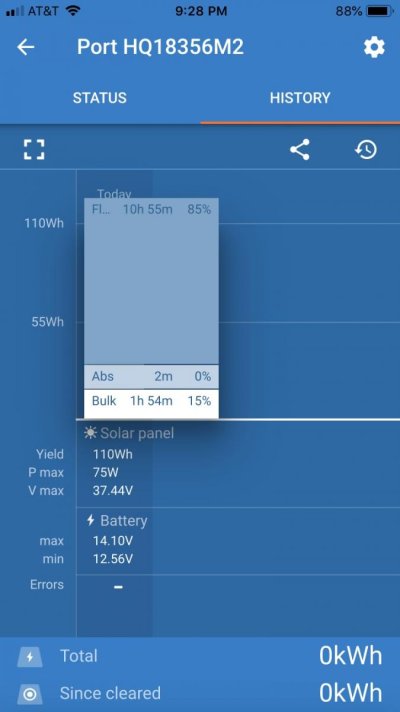STB
Guru
Hi cardude01,
This is where David and I disagree.
He is correct that the panels are current limited and can't fry the wiring. This is why I have consistently referred to it as a "disconnect" not "circuit protection" on the panel side.
And, unless you are dealing with a high voltage system, which is unlikely, it is no threat to a human.
As far as I know, there is no ABYC requirement for either a disconnect or circuit protection, and,,just for reference, to my knowledge, NEC only requires it when multiple strings are wired in parallel such that the current from 2 or mote can overpower the wiring of 1. Think about 3 strings joining a common bus. The protection would be requires on each of the 3 strings, not the common bus.
But, I still very strongly advocate for a disconnect. I don't like poking at live things when it is avoidable.
Earlier I said I wanted the disconnect when adjusting voltage. I was misremembering. I did that live to see the voltage output.
When I wanted the disconnect is when I was changing wiring to and had to slide wires through an energized controller to get them out and put pliers in to tight spots to trim the exposed wire first, and dropped some of that wire as I did.
Now...just because the two supply wires are rated for the maximum current suppliable by the panels most certainly doesnt mean any two points in that controller box are. Screwing up poking live can potentially damage things.
So, what you need in this case is no more that what you'd like.
I used breakers because, at the time, I'd just bought the boat and didn't know the panel rating to know the wiring was safe. Enough else was wrong, that I just figured it couldn't hurt. It was still only half protection, because, if that'd been a problem, the short could have been before the breaker. So, it was a good disconnect but not adaquate as circuit protection. Regardless, I eventually got the spec sheet and the wiring was fine.
A cheap way is just to use a plug disconnect as it goes into the controller or, if reachable, at the too. This way you are only adding one crimp connection, not two.
This is where David and I disagree.
He is correct that the panels are current limited and can't fry the wiring. This is why I have consistently referred to it as a "disconnect" not "circuit protection" on the panel side.
And, unless you are dealing with a high voltage system, which is unlikely, it is no threat to a human.
As far as I know, there is no ABYC requirement for either a disconnect or circuit protection, and,,just for reference, to my knowledge, NEC only requires it when multiple strings are wired in parallel such that the current from 2 or mote can overpower the wiring of 1. Think about 3 strings joining a common bus. The protection would be requires on each of the 3 strings, not the common bus.
But, I still very strongly advocate for a disconnect. I don't like poking at live things when it is avoidable.
Earlier I said I wanted the disconnect when adjusting voltage. I was misremembering. I did that live to see the voltage output.
When I wanted the disconnect is when I was changing wiring to and had to slide wires through an energized controller to get them out and put pliers in to tight spots to trim the exposed wire first, and dropped some of that wire as I did.
Now...just because the two supply wires are rated for the maximum current suppliable by the panels most certainly doesnt mean any two points in that controller box are. Screwing up poking live can potentially damage things.
So, what you need in this case is no more that what you'd like.
I used breakers because, at the time, I'd just bought the boat and didn't know the panel rating to know the wiring was safe. Enough else was wrong, that I just figured it couldn't hurt. It was still only half protection, because, if that'd been a problem, the short could have been before the breaker. So, it was a good disconnect but not adaquate as circuit protection. Regardless, I eventually got the spec sheet and the wiring was fine.
A cheap way is just to use a plug disconnect as it goes into the controller or, if reachable, at the too. This way you are only adding one crimp connection, not two.






